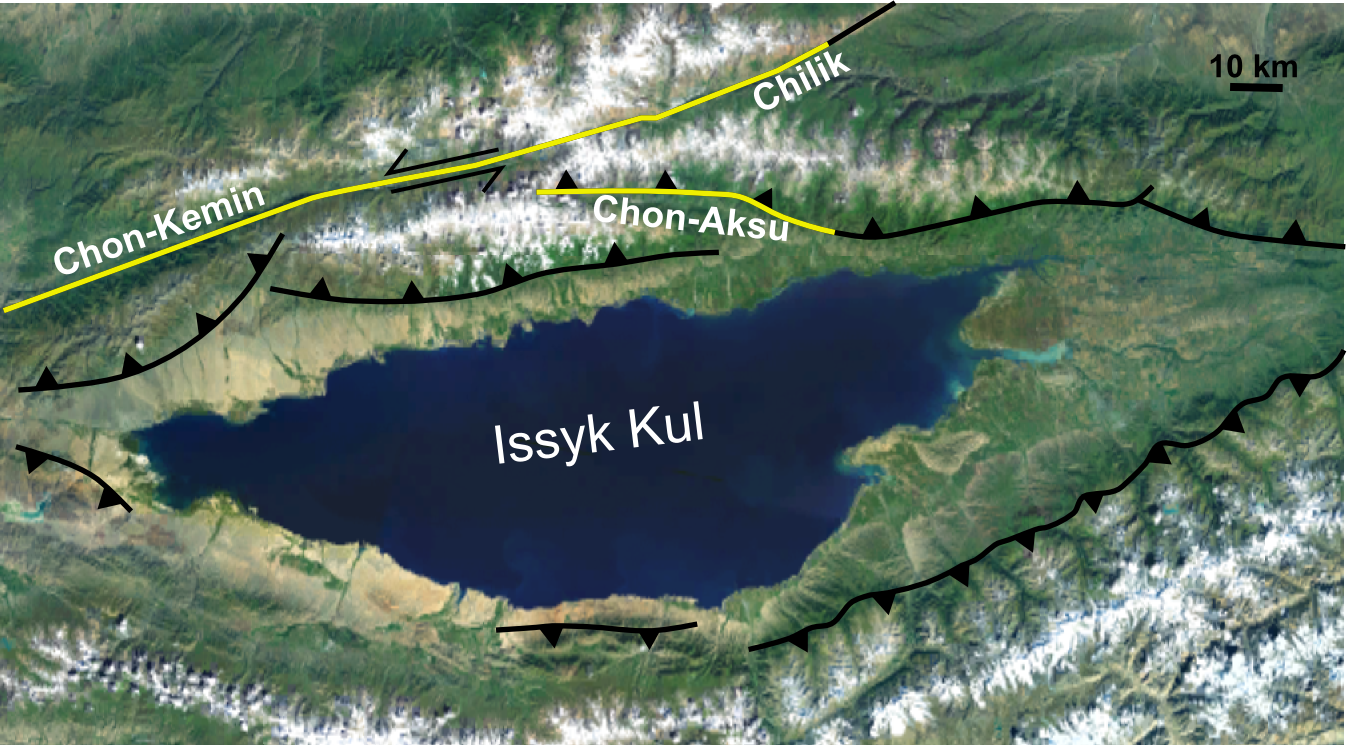|
1911 Kebin Earthquake
The 1911 Kebin earthquake, or Chon-Kemin earthquake, struck Russian Turkestan on 3 January. Registering at a moment magnitude of 8.0, it killed 452 people, destroyed more than 770 buildings (which was almost all of the city) in Almaty, Kazakhstan, and resulted in of surface faulting in the valleys of Chon-Kemin, Chilik and Chon-Aksu. Tectonic setting The Tien Shan mountains form part of the broad zone of deformation associated with the continuing collision between the Indian plate and the Eurasian plate. In the region around Issyk Kul, the tectonic regime is a combination of thrusting and sinistral strike-slip. The lake is formed in a ramp basin bounded to both north and south by opposite verging thrust faults, while the major Chon-Kemin–Chilik strike-slip fault runs along the linear valleys to the north. Characteristics In the Chong-Kemin and Chilik valleys, and on the shoreline of Issyk Kul, a complex zone of surface rupture was identified by fieldwork immediate ... [...More Info...] [...Related Items...] OR: [Wikipedia] [Google] [Baidu] [Amazon] |
Kyrgyzstan
Kyrgyzstan, officially the Kyrgyz Republic, is a landlocked country in Central Asia lying in the Tian Shan and Pamir Mountains, Pamir mountain ranges. Bishkek is the Capital city, capital and List of cities in Kyrgyzstan, largest city. Kyrgyzstan is bordered by Kazakhstan to the Kazakhstan–Kyrgyzstan border, north, Uzbekistan to the Kyrgyzstan–Uzbekistan border, west, Tajikistan to the Kyrgyzstan–Tajikistan border, south, and China to the China–Kyrgyzstan border, east and southeast. Ethnic Kyrgyz people, Kyrgyz make up the majority of the country's over 7 million people, followed by significant minorities of Uzbeks and Russians. Kyrgyzstan's history spans a variety of cultures and empires. Although geographically isolated by its highly mountainous terrain, Kyrgyzstan has been at the crossroads of several great civilizations as part of the Silk Road along with other commercial routes. Inhabited by a succession of tribes and clans, Kyrgyzstan has periodically fallen unde ... [...More Info...] [...Related Items...] OR: [Wikipedia] [Google] [Baidu] [Amazon] |
Thalweg
In geography, hydrography, and fluvial geomorphology, a thalweg or talweg () is the line or curve of lowest elevation within a valley or watercourse. Normally only the horizontal position of the curve is considered (as viewed on a map); the corresponding vertical position is represented in a '' stream profile''. Under international law, a thalweg is instead taken to be the middle of the primary navigable channel of a waterway which is the default legal presumption for the boundary between entities such as states. Thalwegs can have local proprietorial and administrative significance because their formerly somewhat shifting position, reliant on renewed soundings, now more fixed as described internationally, is part of centuries-old custom and practice in some jurisdictions. In some jurisdictions and between some states the median line (between banks) is the preferred boundary presumption as may extend from estuaries. Also being easy to map, drawing "turning points" are the s ... [...More Info...] [...Related Items...] OR: [Wikipedia] [Google] [Baidu] [Amazon] |
January 1911
The following events occurred in January 1911: January 1, 1911 (Sunday) *The Australian Capital Territory officially came into existence, and the Northern Territory was politically separated from South Australia and transferred to Commonwealth control. *General Juan Jose Estrada was inaugurated s the new President of Nicaragua"Record of Current Events", ''The American Monthly Review of Reviews'' (February 1911), pp. 159–162. *The Evangeline Parish, Louisiana, was created, after being separated from the St. Landry Parish, Louisiana, Parish of St. Landry. *Under 38 U.S.C. 2301, a medal for Mexican Border Service could be awarded for any U.S. soldier who served between January 1, 1911, and April 5, 1917. *Stamps were first issued for the Gilbert and Ellice Islands, now the nations of Kiribati and Tuvalu. *The magazine ''Barton's Boys' Life'', which would later become ''Boys' Life'' and the official Boy Scouts of America magazine, was first published. *Toccoa Falls College was cr ... [...More Info...] [...Related Items...] OR: [Wikipedia] [Google] [Baidu] [Amazon] |
1911 Earthquakes
Events January * January 1 – A decade after federation, the Northern Territory and the Australian Capital Territory are added to the Commonwealth of Australia. * January 3 ** 1911 Kebin earthquake: An earthquake of 7.7 Moment magnitude scale, moment magnitude strikes near Almaty in Russian Turkestan, killing 450 or more people. ** Siege of Sidney Street in London: Two Latvian people, Latvian anarchists die, after a seven-hour siege against a combined police and military force. Home Secretary Winston Churchill arrives to oversee events. * January 4 – Comparison of the Amundsen and Scott expeditions, Amundsen and Scott expeditions: Robert Falcon Scott's British Terra Nova Expedition, ''Terra Nova'' Expedition to the South Pole arrives in the Antarctic and establishes a base camp at Cape Evans on Ross Island. * January 5 – Egypt's Zamalek SC is founded as a general sports and Association football club by Belgian lawyer George Merzbach as Q ... [...More Info...] [...Related Items...] OR: [Wikipedia] [Google] [Baidu] [Amazon] |
Earthquakes In Kyrgyzstan
An earthquakealso called a quake, tremor, or tembloris the shaking of the Earth's surface resulting from a sudden release of energy in the lithosphere that creates seismic waves. Earthquakes can range in intensity, from those so weak they cannot be felt, to those violent enough to propel objects and people into the air, damage critical infrastructure, and wreak destruction across entire cities. The seismic activity of an area is the frequency, type, and size of earthquakes experienced over a particular time. The seismicity at a particular location in the Earth is the average rate of seismic energy release per unit volume. In its most general sense, the word ''earthquake'' is used to describe any seismic event that generates seismic waves. Earthquakes can occur naturally or be induced by human activities, such as mining, fracking, and nuclear weapons testing. The initial point of rupture is called the hypocenter or focus, while the ground level directly above it is the epicen ... [...More Info...] [...Related Items...] OR: [Wikipedia] [Google] [Baidu] [Amazon] |
1902 Turkestan Earthquake
The 1902 Turkestan earthquake (also known as the Artush or Kashgar earthquake) devastated Xinjiang, Qing dynasty, China, near the Kyrgyzstan border. It occurred on August 22, 1902, at 03:00:22 (09:00:22 local time) with an epicenter in the Tien Shan mountains. The thrust earthquake measured 7.7 on the moment magnitude scale () and had a depth of . The Tien Shan mountains is situated in a zone of complex convergence caused by the Indian–Eurasian plate interaction. This zone is actively deforming—accommodated by active thrust faults responsible for seismic activity. The mainshock was preceded by an intense series of foreshocks in the years prior. Many aftershocks followed, several were larger than magnitude 6.0 and the largest measured 6.8–7.3. Aftershocks were recorded for three years. Additional shocks were recorded over a decade after the mainshock. An estimated 5,650–10,000 people were killed in the mainshock. Widespread destruction occurred—at least 30,000 homes wer ... [...More Info...] [...Related Items...] OR: [Wikipedia] [Google] [Baidu] [Amazon] |
List Of Earthquakes In Kyrgyzstan ...
The following is a list documenting major earthquakes that have occurred in Kyrgyzstan. The list also include earthquakes with epicenters outside the country, but caused significant impact in Kyrgyzstan. List References Source * {{Earthquakes in Kyrgyzstan Kyrgyzstan * Natural disasters in Kyrgyzstan Geology of Kyrgyzstan Earthquakes An earthquakealso called a quake, tremor, or tembloris the shaking of the Earth's surface resulting from a sudden release of energy in the lithosphere that creates seismic waves. Earthquakes can range in intensity, from those so weak they c ... [...More Info...] [...Related Items...] OR: [Wikipedia] [Google] [Baidu] [Amazon] |
List Of Earthquakes In 1911 ...
This is a list of earthquakes in 1911. Only magnitude 6.0 or greater earthquakes appear on the list. Lower magnitude events are included if they have caused death, injury or damage. Events which occurred in remote areas will be excluded from the list as they wouldn't have generated significant media interest. All dates are listed according to UTC time. Overall By death toll * Note: At least 10 casualties By magnitude * Note: At least 7.0 magnitude Notable events January February March April May June July August September October November December References {{Earthquakes in 1911 1911 1911 Events January * January 1 – A decade after federation, the Northern Territory and the Australian Capital Territory are added to the Commonwealth of Australia. * January 3 ** 1911 Kebin earthquake: An earthquake of 7.7 m ... [...More Info...] [...Related Items...] OR: [Wikipedia] [Google] [Baidu] [Amazon] |
Yurt
A yurt (from the Turkic languages) or ger (Mongolian language, Mongolian) is a portable, round tent covered and Thermal insulation, insulated with Hide (skin), skins or felt and traditionally used as a dwelling by several distinct Nomad, nomadic groups in the Eurasian Steppe, steppes and Tian Shan, mountains of Inner Asia. The structure consists of a flexible angled assembly or latticework of wood or bamboo for walls, a door frame, ribs (poles, rafters), and a wheel (crown, compression ring) possibly steam-bent as a roof. The roof structure is sometimes self-supporting, but large yurts may have interior posts or columns supporting the crown. The top of the wall of self-supporting yurts is prevented from spreading by means of a tension band which opposes the force of the roof ribs. Yurts take between 30 minutes and three hours to set up or take down, and are generally used by between five and 15 people. Nomadic farming with yurts as housing has been the primary way of life in Cen ... [...More Info...] [...Related Items...] OR: [Wikipedia] [Google] [Baidu] [Amazon] |





